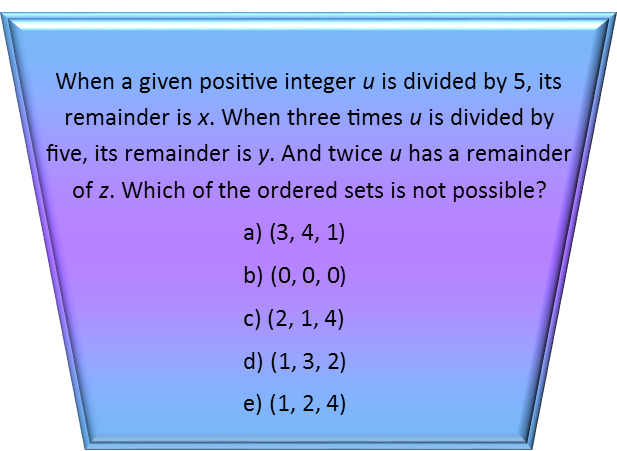Math Made Easy: Problem of the Day 61

I havenít done many plug and play problems yet. Usually the method is best used for multiple choice questions, and I personally canít stand multiple choice tests. Theyíre not designed for the studentís interest in mind, but for the teacherís (for ease of grading). But it can still be a valuable method, so I broke down to demonstrate it using this multiple choice problem today.
The remainder is simply whatís left over when you divide one number by another. For number that go into another evenly, there is no remainder, itís simply zero. And a remainder can never be larger than the divisor. Knowing this, we could set up equations. BUT. Thatís a huge waste of time. Itís really fastest to just pick a number that we know has a given remainder when divided by whatever our divisor is, and test to see what happens. Thatís why we call it the plug and play method: pick a number, plug it in, and play with it.
So letís do that with each ordered set.
For set a, the first number I know that has a remainder of three when divided by five is 8. So we multiply 8 by three and test it, and by two, and test that. Note that I use remainder notation below, which reads ď8 divided by five is 1 remainder 3Ē. The ďRĒ just means remainder.

Set a works.
The second ordered set is a gimme. For any number to have a remainder of 0 when divided by 5, it must be a multiple of 5. So any multiple of that number will also have a remainder of 0. So set b also works.
For set c may seem a little trickier, I'm going to test a number SMALLER than 5, just to show they'll work the same. And 2, which is smaller than 5, when divided by 5, has a remainder of 2. So letís test it:

Set c works as well.
For set d, letís use what we just learned from set c and start with a number smaller than 5 first. So letís pick 1, since it does have a remainder of 1 when divided by 5.

That set works fine.
For the final set, we don't need to try anything, since we've already tested a number with a remainder of 1. The ordered sets don't match, so e is not possible, which makes it our answers. To speed things up, we could have started with d and e, since only one of the sets could have worked. By finding which one doesn't, we'd actually eliminate the need to check choices a, b, and c, unless the directions had been "select all that apply."
So problems like this are a beautiful demonstration of how the plug and play method can be useful in cases where it may not be obvious how to draft equations to solve your situation. It can be easier, and sometimes faster. It does work best for multiple choice tests, since the answers do give you an idea of where to start, but if you have a good enough number familiarity, it can be used in cases where you donít have a list of answers from which to choose.
|



